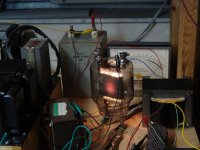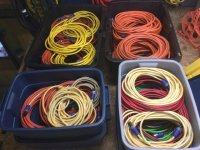Stranded wire has many points where the wires touch each other. This creates a smearing effect as the signal jumps from one wire to the other.
Really now. I'll have to see if the signal is jumping around in my system. I use stranded copper wire, 22 gauge, for most of my assembly.
Just an observation: even my prototypes look neater and more professional than this. I picture Dueling Banjos playing in the background while he assembles the devices.
OKalignment of atoms within the wire.
I've been doing it all wrong. I'm going to see if I can get a refund on my education.
...and it'll still take 6 weeks at that price.
That's a deal breaker for me. Otherwise I'd be ordering a dozen of these.
I can only imagine how amazing they would sound when connected between my Soundblaster and my 80s Lloyds all-in-one sound system.
That's a deal breaker for me. Otherwise I'd be ordering a dozen of these.
I can only imagine how amazing they would sound when connected between my Soundblaster and my 80s Lloyds all-in-one sound system.
Last edited:
Upgrade the tranny and you could run 12BH7 - for some seriously smooth sound. Everyone knows they are way better than your run-of-the-mill 12AU7. 

Pffft! My active screen cables use nothing less than DH SET. 2A3 or PX4 for smaller genres of music, 300B for orchestral and opera.
Dumb question, but how can you have a driven shield Coax if it's designed to plug into ordinary gear with shield grounded?
You technical guys can never see the trees due to the forest! Always so focused on physics and never on the way the music makes you feel! 😉
Having said that, obviously these cables are designed not only to sound amazing, but to also reveal the weeknesses of your connected devices. So much so, that lesser devices ("ordinary gear") will simply malfunction - making it obvious what the weakest links in your system are.
Well worth the money, when you consider all that.
Having said that, obviously these cables are designed not only to sound amazing, but to also reveal the weeknesses of your connected devices. So much so, that lesser devices ("ordinary gear") will simply malfunction - making it obvious what the weakest links in your system are.
Well worth the money, when you consider all that.
Last edited:
Pffft! My active screen cables use nothing less than DH SET. 2A3 or PX4 for smaller genres of music, 300B for orchestral and opera.
Really, The use of such ordinary tubes in this very specific application, would render the music unlistenable. Something akin to putting all of the musically pleasant sounds in a blender and pressing the "liquify" button, turning them all to mush.
In order to achieve the best possible outcome in an active shield application, one must choose a DHT that is capable of driving all stray capacitance and inductance right out of the cable.....and keeping it out! In order to repel these unwanted parasitics far enough from the cable that they pose no threat to the music, a strong musically modulated electrostatic field that will surround the cable protecting it must be generated.
A careful engineering study using only the finest interconnects, tube sockets crafted from premium metals, and premium analog measuring equipment to avoid digital interference was done to determine the proper DHT for the job, the 833A, and its optimum bias point, 1500 volts at 270 mA.
For the best listening enjoyment the active shield system should be activated several minutes prior to listening to remove all traces of parasitic resonances before they can pollute the listening space. This invokes that nice warm feeling during listening.
Attachments
George,
I also use Wal-Mart speaker cable. But it’s just that cheap Woods brand extension cord. I’m probably one of the only guys that has a $10k (bought them when they where discontinued, paid half) speaker driven by a Wal-Mart extension cord! 😀
No, you’re not the only one. Maybe twice that, in PA speakers, all powered by extension cords. If I had a dollar for everyone who told me I’m going to get in trouble for code violations I’d be filthy rich, enough to make a 100 foot 32x snake with those tube-powered shield drivers.
Attachments
No clue about that so had to watch a couple videos by somebody called The Duttons Siblings or something.I picture Dueling Banjos playing in the background while he assembles the devices.
Incredible picking!!! I loved it.
Thanks for mentioning them.
Member
Joined 2009
Paid Member
I didn’t read the instructions, but don’t you need to align the cables with the earth’s magnetic field ?
Have you never seen the film "dueling banjos"?
Don't you mean 'deliverance'?
the 833A, and its optimum bias point, 1500 volts at 270 mA.
Dilbert: Dont touch the prototype.
Pointy-haired boss: Must touch - Zaaapp!
Dilbert: Dont touch it a second time.
Pointy-haired boss: Must touch -
Your employ of vice-grips as both a stand and for making connection is priceless!
With the right antenna I should be able to power my speakers directly from that, without any cable or amp at all! Nikola Tesla would be pleased ;-)the 833A, and its optimum bias point, 1500 volts at 270 mA
In order to achieve the best possible outcome in an active shield application, one must choose a DHT that is capable of driving all stray capacitance and inductance right out of the cable.....and keeping it out! In order to repel these unwanted parasitics far enough from the cable that they pose no threat to the music, a strong musically modulated electrostatic field that will surround the cable protecting it must be generated.
But that will cause a major inerference with my stacked elecrostatics!! I'll have to invesitgate, and think about this .....
NOT! 😀
- Home
- Member Areas
- The Lounge
- Tube powered active interconnect cable

